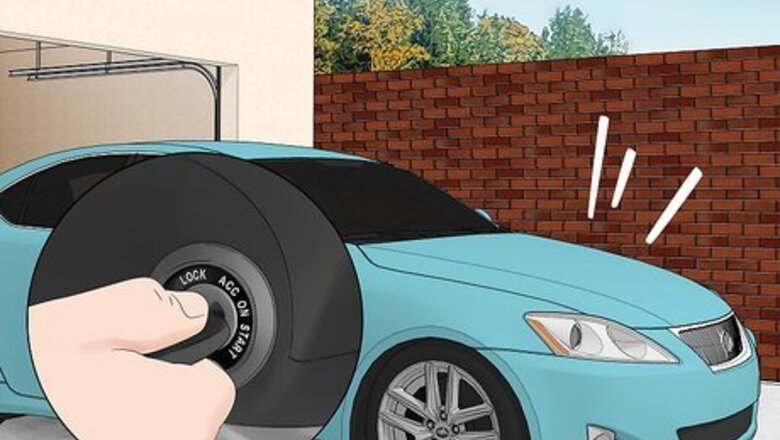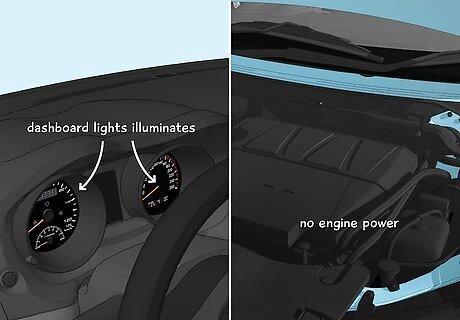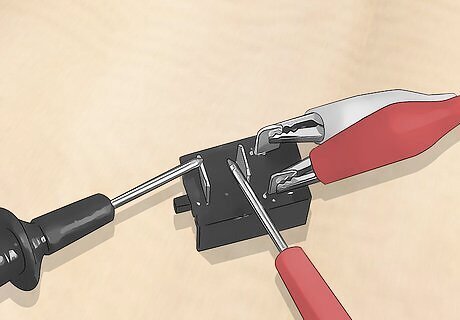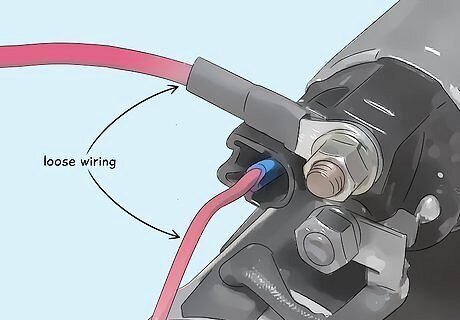
views
- A bad starter may make clicking, whirring, or grinding noises when you start your vehicle, which usually indicates worn-out parts or electrical connections.
- If your starter is bad but your battery works, your vehicle’s lights will work but your engine won’t start.
- Oil leaking the starter and smoke coming from under your hood are signs of serious damage to your starter.
Symptoms of a Bad Starter

Engine not cranking or starting Tom Eisenberg, an auto technician, says that “your starter's job is to kick over your engine…your battery sends your starter a little punch, which …starts the engine.” If your engine doesn’t crank when you turn the key, it could potentially be an issue with your starter. Another potential cause of your engine not turning over is a dead battery. Check your battery by touching the terminals with a voltmeter and looking for a 12 V reading. If a starter is beginning to go bad, then it may take turning the key a few times to turn over the engine.

Clicking or whirring noises Auto technician Jason Shackelford says that “when turning the key to crank the engine, sometimes it may just make a click sound” if there’s a bad starter solenoid, or the cylindrical electrical component attached to the starter motor. You may also hear a clicking or whirring noise if there’s damage to the starter’s drive gear or engine’s flywheel, which is the large gear that provides power to your engine.

Lit dashboard lights but no engine power If the dashboard lights or headlights illuminate when you turn the key, that means the battery is connected properly but something is faulty with your starter.

Oil covering the starter Your starter is a cylindrical metal piece that’s usually on the passenger side of your vehicle’s engine. If your engine leaks onto the starter and it looks soaked in oil, then it could be preventing your car from starting. Because the oil can get inside the starter and cause it to malfunction, it usually requires the help of a professional mechanic to clean and fix.

Smoke coming from under the hood A bad starter may also get stuck and stay engaged after your engine turns over, which can cause it to overheat. If you notice smoke coming from under your engine and there’s a burning smell, then it’s a sign of serious damage to the starter.
Troubleshooting a Bad Starter

Tighten any loose connections on your starter and battery. Pop open your hood and look for the cylindrical starter on the passenger side of your engine. Inspect the wire connections connecting to your starter, and tighten them with a wrench if they feel loose. Follow the wires connecting to your starter back to the battery, and tighten any loose nuts or bolts that you find. If you see rust or corrosion on the battery terminals, clean them with toothbrush soaked with a mix of 1 tbsp (17 g) of baking soda and 1 c (240 ml) of warm water.

Test the power wires and fuses on the starter with a voltage tester. To test your starter, look for the large and small power wires attached to it. Hold the tip of the voltage tester against each wire’s terminal. If both of the wires have a 12 V reading, then it’s a sign your starter is going bad. When you’re testing the voltage of the smaller wire terminal, turn the key in the ignition to get an accurate reading. To test the car fuses, find the starter fuse using the guide in your vehicle’s manual. Locate the fuse box under the hood under a plastic cover. Look in the middle of the fuse to see if the connection is broken inside.

Check the starter relay resistance and voltage with a multimeter. The starter relay is a plug that delivers power to your starter, and it’s located on the positive lead near your battery. Set your multimeter to ohms. Place the multimeter leads on the ignition switch circuit connected with a black thin wire and on the ground terminal of the starter. If the reading is higher than 5 ohms, then the starter relay is malfunctioning and needs to be replaced. To test voltage, set the multimeter to volts. Hold the red probe to the red connection on the battery and the other probe on the ignition switch circuit. Have someone turn the key and check the voltage. If it’s higher than 0.2 V, then the relay is malfunctioning. Because replacing a relay involves a lot of electrical parts, it’s best to take your vehicle to a mechanic for repairs.

Try starting your vehicle in neutral to diagnose a bad safety switch. The safety switch prevents your vehicle from starting unless it’s in park or neutral, but a faulty one may prevent your starter from working. Engage your handbrake and shift your vehicle into neutral. Then, try turning the key to see if your vehicle starts. If your vehicle starts, then the safety switch is probably your issue. If your vehicle still doesn’t start, there may be a problem with another part of your starter. Because the safety switch is difficult to access and could prevent your car from starting, take your vehicle to a mechanic to have it repaired.

Look for and fix oil leaks on your engine. Pop open your hood and look for leaking oil trailing down the side of your engine by the starter. Try to tighten any nuts or bolts around the leaking section of your engine. If you notice any damage to the rubber gaskets on your engine, then visit a mechanic to have them replaced. Oil leaks may also trigger the Check Engine light on your dashboard.
Starting a Vehicle with a Bad Starter

Try jump-starting your vehicle if the battery is dead. Park a working vehicle next to the vehicle that won’t start. Attach the ends of a jumper cable to the positive terminals on each battery. Then, connect the negative terminals with the other. Run the working vehicle for a few minutes before trying to start the other vehicle. If your battery is already in good condition, jump-starting your vehicle will not make the starter work again.

Tap the starter with a hammer for a temporary fix. Auto technician Tom Eisenberg states that “sometimes the starter gets stuck.” He recommends “hit[ting] it with a hammer or a piece of wood…and that sometimes loosens it up” so your vehicle can start.

Bypass a faulty starter relay with an insulated screwdriver. If you want to start your car, hold the grip of an insulated screwdriver. Touch the middle of the screwdriver to the positive terminal on the starter and the terminal solenoid. The burst of power may be enough to start your vehicle. Do not touch the metal of the screwdriver while you’re bypassing the relay because it could shock you.

Bump-start manual transmission vehicles to bypass the starter. If you drive a manual vehicle, shift into neutral and have another person push your vehicle. Once you reach 5–10 miles per hour (8.0–16.1 km/h), try starting your vehicle to see if you have enough power to turn over the engine.

Take your vehicle to a mechanic to repair or replace the bad starter. Starting your vehicle with a bad starter is usually temporary and won’t solve the issue. After you get your vehicle running, take it right to a mechanic or shop to have it properly inspected and repaired.
What causes a bad starter?

Loose wiring If any of the wires connecting the starter to your battery aren’t fitted tightly, then the electrical current can’t provide power to your starter.

Dirty or corroded connections Rust and corrosion on the battery terminals or wire connectors prevent your starter from receiving full power.

Bad battery If your battery doesn’t have a full charge or has corroded parts, it won’t be able to provide enough power to your starter to turn over the engine.

Worn out or faulty components Over time, the gears and moving parts in your starter wear down and aren’t able to connect to the engine properly, preventing it from starting. This typically happens in older vehicles, but parts may wear down or malfunction at any time.

Oil leaks When oil leaks from your engine into the starter, it can clog up the parts and prevent it from operating.



















Comments
0 comment